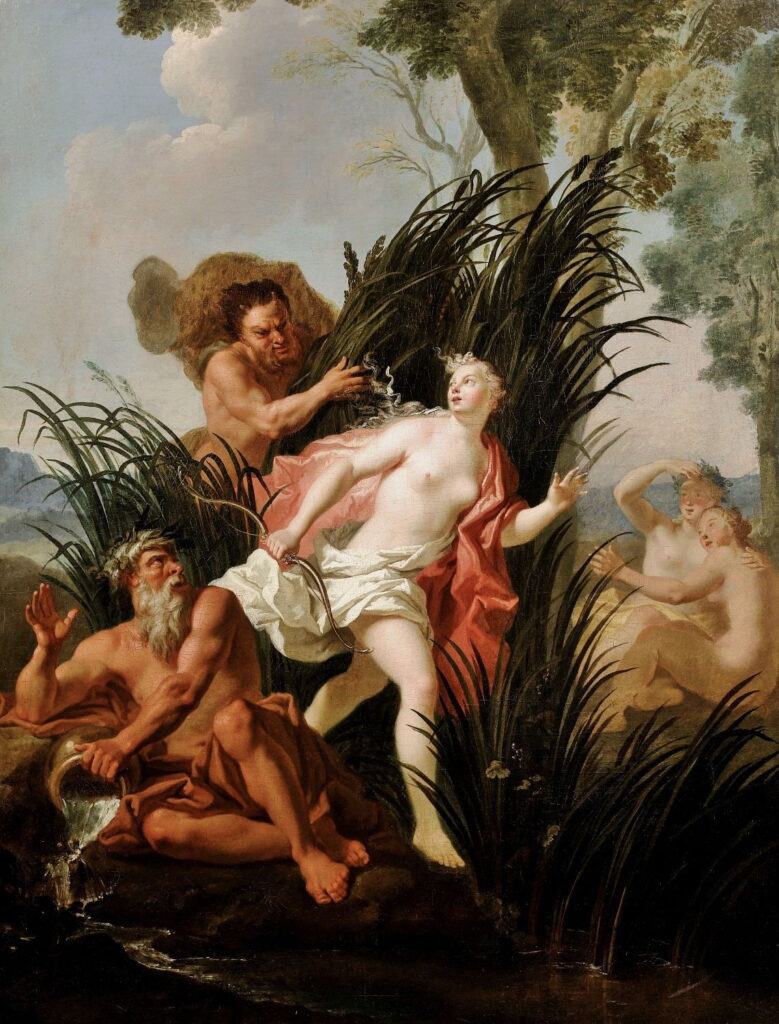Changing Paintings: 23 Arethusa, Lyncus and the magpies

Calliope, the Muse of epic poetry, has just finished telling the long and harrowing story of the rape of Proserpine. She moves on to conclude with two shorter stories, the first about Arethusa who had told Ceres of Pluto’s abduction of Proserpine.
Ceres, Proserpine’s mother, is delighted when her daughter is restored to her from the underworld, even if it is only for half the year. She thanks Arethusa for her help, and asks how she came to be made into a sacred stream.
Arethusa says that she had been a nymph in Achaea. One day she had been returning from hunting in the heat, and started to bathe in a stream to cool off. As she was about to slip into the clear water she removed her clothes and hung them from a tree, when the river god Alpheus suddenly appeared and called her. She took fright and fled, leaving her clothes behind.
At first, Arethusa was able to keep her pursuer at a comfortable distance, but as they ran further, she began to tire and sensed him drawing closer. When she was exhausted, she called on Diana to come to her aid, resulting in her being enveloped in cloud. Although Alpheus couldn’t see her any more, he waited, trying to discover where she had gone, but she was dissolving into a stream. That was joined by Alpheus’ river, only to disappear into the ground in a rock cleft (what’s known in limestone terrain as a swallet hole) to reach Diana’s island of Ortygia, in the centre of the city of Syracuse, on Sicily.
Carlo Maratta (1625–1713), Alpheus and Arethusa (c 1680), oil on canvas, 98.8 × 133.1 cm, location not known. Wikimedia Commons.
Although popular in Rome at the time, Carlo Maratta has been largely forgotten now. His Alpheus and Arethusa, probably from around 1680, shows Diana, distinguished by her crescent moon symbol, intervening by bringing cloud down to conceal the nymph, just as Alpheus is about to catch her up. The landscape behind includes a watery area where Maratta may have painted another scene, perhaps after Arethusa’s transformation.
Luigi Garzi (attr) (1638–1721), Alpheus and Arethusa (c 1690), oil on canvas, 120.7 x 171.5 cm, location not known. Wikimedia Commons.
Attributed to Luigi Garzi, another popular painter in Rome in that period, Alpheus and Arethusa from perhaps slightly later, around 1690, includes a similar group of figures. Diana is again in the clouds, and passing clouds down to hide Arethusa from Alpheus. Oddly, the nymph is here fully dressed, and it’s her pursuer who is nude. Under their feet, and under the watching eyes of another river god and nymphs, the couple are starting to transform into rivulets of water, which combine and drop into a small pool joining a larger river at the far right.
Antoine Coypel (1661–1722), Alpheus Chasing Arethusa (c 1710), oil on canvas, dimensions and location not known. Wikimedia Commons.
Antoine Coypel’s slightly later Alpheus Chasing Arethusa, probably from about 1710, oddly omits Diana. Arethusa, still carrying her bow, is just about to be caught by a faun-like Alpheus, as she passes another river god. In the background, two other nymphs look on in surprise.
John Martin (1789–1854), Alpheus and Arethusa (1832), oil, dimensions and location not known. Wikimedia Commons.
A century passed before this myth was told again in a major narrative painting, this time by John Martin. His Alpheus and Arethusa (1832) is a powerful work whose figures are so tiny that they could easily be overlooked were it not for the pale pink flesh of Arethusa.
Ceres then harnesses a pair of dragons to her chariot, and travels to visit Triptolemus to give him seed to be sown in unproductive land that has never been cultivated or has long lain fallow.
“Aberdeen Painter”, Triptolemus and Korē (c 470-460 BCE), tondo of a red-figure Attic cup discovered at Vulci, 36 cm diameter, Musée du Louvre, Paris. Image by Jastrow, via Wikimedia Commons.
This tondo of a red-figure Attic cup, now in the Louvre, is typical of classical depictions of Triptolemus and Ceres, and dates from 470-460 BCE. The young deity is sat in Ceres’ special winged chariot, as she provides him with seed to be distributed to the lands around the world.
Jerzy Siemiginowski-Eleuter (1660–1711), Allegory of Summer (1684—86), oil on canvas, 550 × 435 cm, Muzeum Pałacu Króla Jana III w Wilanowie, Warsaw, Poland. Wikimedia Commons.
Triptolemus assumes the same role in the left foreground of Jerzy Siemiginowski-Eleuter’s splendid Allegory of Summer (1684—86), made as a ceiling painting for the bedroom of King John III Sobieski of Poland.
Ceres herself is in the centre foreground, handing an unusual blue floral wreath to Triptolemus. Above him is an allegory of the night, with the figure of Aurora-Astraea, who was modelled by Queen Marysieńka (Marie Casimire Louise de la Grange d’Arquien), wife of King John III Sobieski of Poland (1629-1696). Low in the sky is the ‘dog star’, generally visible across Europe during the summer, and above is the chariot of the sun in the constellation of the lion, Leo. These symbols of summer are coupled with the more obvious signs of harvest, to complete this elaborate seasonal allegory.
Károly Brocky (1807–1855), Ceres and Triptolemos (c 1853), oil on canvas, 139 x 119 cm, Ottó Herman Museum, Miskolc, Hungary. Wikimedia Commons.
Károly Brocky’s Ceres and Triptolemos (c 1853) is a later and simpler evocation of these gods and their roles in productive agriculture, using a quiet form of multiplex narrative. In the foreground, Ceres is bidding the young Triptolemus to sow seed from the bag carried by a young child, while the harvest is in full swing in the background, many months after that seed would have been sown.
The young Triptolemus flies away in Ceres’ chariot, and eventually comes to Scythia, where he enters the palace of Lyncus its king. Triptolemus provides him with seed, promising him rich harvests from it. Lyncus is jealous, though, so entertains Triptolemus lavishly; when the young man is sound asleep he tries to stab him in the heart. Ceres intervenes, and transforms Lyncus into a lynx.
That completes the stories sung by the Muses in their contest against the nine pretenders, the Pierides. Ovid closes the book by reminding us of the fate of the Pierides, who were transformed into magpies.


